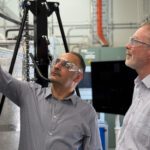Curtin scientists are part of an international research team that studied an ancient supervolcano in Indonesia and found such volcanoes remain active and hazardous for thousands of years after a super-eruption, prompting the need for a rethink of how these potentially catastrophic events are predicted.
Associate Professor Martin Danišík, lead Australian author from the John de Laeter Centre based at Curtin University, said supervolcanoes often erupted several times with intervals of tens of thousands of years between the big eruptions but it was not known what happened during the dormant periods.
“Gaining an understanding of those lengthy dormant periods will determine what we look for in young active supervolcanoes to help us predict future eruptions,” Associate Professor Danišík said.
“Super-eruptions are among the most catastrophic events in Earth’s history, venting tremendous amounts of magma almost instantaneously. They can impact global climate to the point of tipping the Earth into a ‘volcanic winter’, which is an abnormally cold period that may result in widespread famine and population disruption.
“Learning how supervolcanoes work is important for understanding the future threat of an inevitable super-eruption, which happen about once every 17,000 years.”
Associate Professor Danišík said the team investigated the fate of magma left behind after the Toba super-eruption 75,000 years ago, using the minerals feldspar and zircon, which contain independent records of time based on the accumulation of gasses argon and helium as time capsules in the volcanic rocks.
“Using these geochronological data, statistical inference and thermal modelling, we showed that magma continued to ooze out within the caldera, or deep depression created by the eruption of magma, for 5000 to 13,000 years after the super-eruption, and then the carapace of solidified left-over magma was pushed upward like a giant turtle shell,” Associate Professor Danišík said.
“The findings challenged existing knowledge and studying of eruptions, which normally involves looking for liquid magma under a volcano to assess future hazard. We must now consider that eruptions can occur even if no liquid magma is found underneath a volcano – the concept of what is ‘eruptible’ needs to be re-evaluated.
“While a super-eruption can be regionally and globally impactful and recovery may take decades or even centuries, our results show the hazard is not over with the super-eruption and the threat of further hazards exists for many thousands of years after.
“Learning when and how eruptible magma accumulates, and in what state the magma is in before and after such eruptions, is critical for understanding supervolcanoes.”
The study was led by researchers from Oregon State University, and co-authored by researchers from Heidelberg University, the Geological Agency of Indonesia, and by Dr Jack Gillespie from Curtin’s School of Earth and Planetary Sciences and The Institute for Geoscience Research (TIGeR), Curtin’s flagship earth sciences research institute.
The paper, ‘Resurgence initiation and subsolidus eruption of cold carapace of warm magma at Toba Caldera, Sumatra’, was published in journal Nature – Earth and Environmental Sciences and can be found online here.



